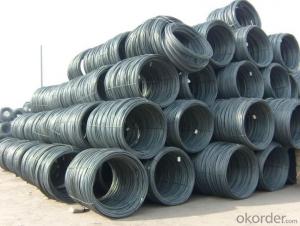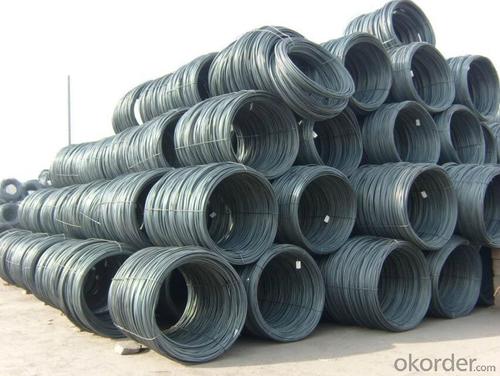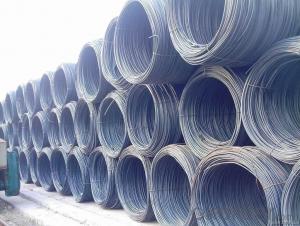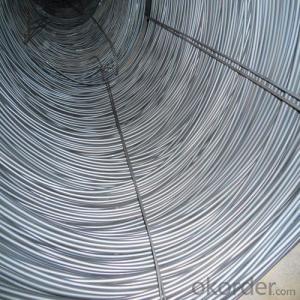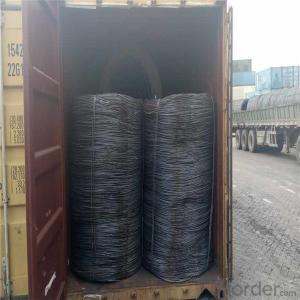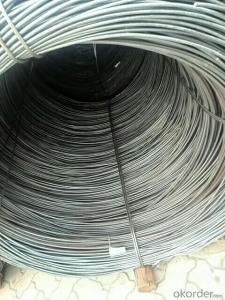high quality SAE1006 / SAE1008B Low Carbon Steel Wired Rod
- Loading Port:
- Tianjin
- Payment Terms:
- TT OR LC
- Min Order Qty:
- 25 m.t.
- Supply Capability:
- 5000 m.t./month
OKorder Service Pledge
OKorder Financial Service
You Might Also Like
Specification
Specifications of Steel Wire Rod in Coil:
Steel Grade: Q195/235, SAE1006-1018B Standard: ASTM, GB
Diameter: 5.5mm, 6.5mm, 7mm,8mm,9mm,10mm,12mm,14mm
Type: Drawn Wire Alloy or Not: Alloy Brand Name: HSKY
Technique: Hot Rolled Place of Origin: China Mainland
Chemical Composition:(Please kindly find our chemistry of our material based on SAE1006B and SAE1008B as below for your information)
High carbon/Low carbon/common carbon Steel wire rod | With boron for rebate tax |
Grade | SAE1006B SAE1008B SAE1018B |
Package | In coil ,in bundle, |
Coil weight | about 2000kg-3000kgs |
Size: | 5.5mm 6.5mm 8mm 10mm 12mm 14mm 16mm |
Types | High Carbon ,Low carbon ,Common carbon |
Exported Country | South Korea,Vietnam,Indonesia,Myanmar,Philippines and Afrca,Ect |
Delivery term: | within 30 days after receive the LC |
Payment Term: | LC at sight ,LC 30-120 days after B/L date, TT payment |
The Standard of Physical Properties:
Grade | Chemical Composition(%) | |||||
C | Mn | Si | S | P | Cr | |
SAE1006 | 0.03~O.07 | ≤0.32 | ≤0.30 | ≤0.045 | ≤0.040 | >0.30 |
Mechanical properties | ||||||
Yield strength(N/mm2) | Tensile strength(N/mm2) | Elongation(%) | ||||
250-280 | 350-380 | ≥32 | ||||
Grade | Chemical Composition(%) | |||||
C | Mn | Si | S | P | Cr | |
SAE1008 | 0.10max | 0.3~O.50 | 0.15max | 0.050max | 0.040 max | 0.30 min |
Mechanical properties | ||||||
Yield strength(N/mm2) | Tensile strength(N/mm2) | Elongation(%) | ||||
≥195 | 315-430 | ≥30 | ||||
Usage and Applications of Steel Wire Rod in Coil:
After hot-rolled the products shaped into coil and delivery as finished product, including round, square, rectangular, hexagonal and so on, Since most of the products are round, it is generally called wire rod. Steel wire rod is widely used in construction and manufacturing. Steel wire rod is mainly used for reinforcement of reinforced concrete and welded structure or reprocessed (roberts, nail etc) materials, especially used to produce wire drawing, welding electrode, nails,spring, electronic, precise machinery parts and so on.
Packaging & Delivery of Steel Wire Rod in Coil:
Packaging Detail: products are packed in coil and then shipped by container or bulk vessel
Each coil weight: 2-3MT
Delivery Detail: within 45 days after received deposit or LC.
Label: to be specified by customer, generally, each bundle has 1-2 labels
Trade terms: CFR, CIF
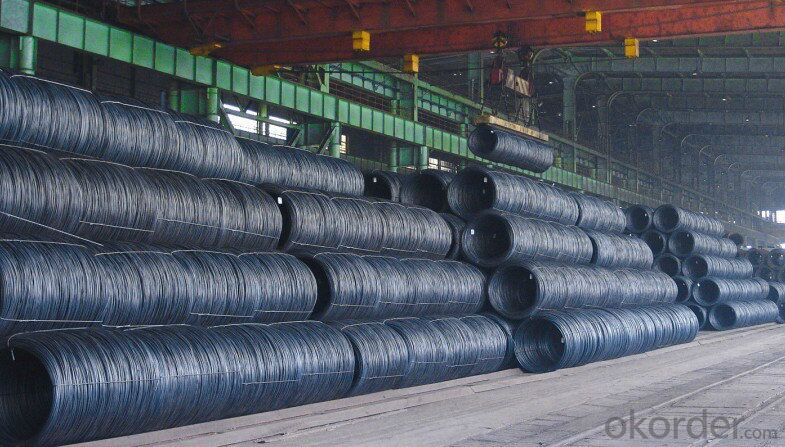
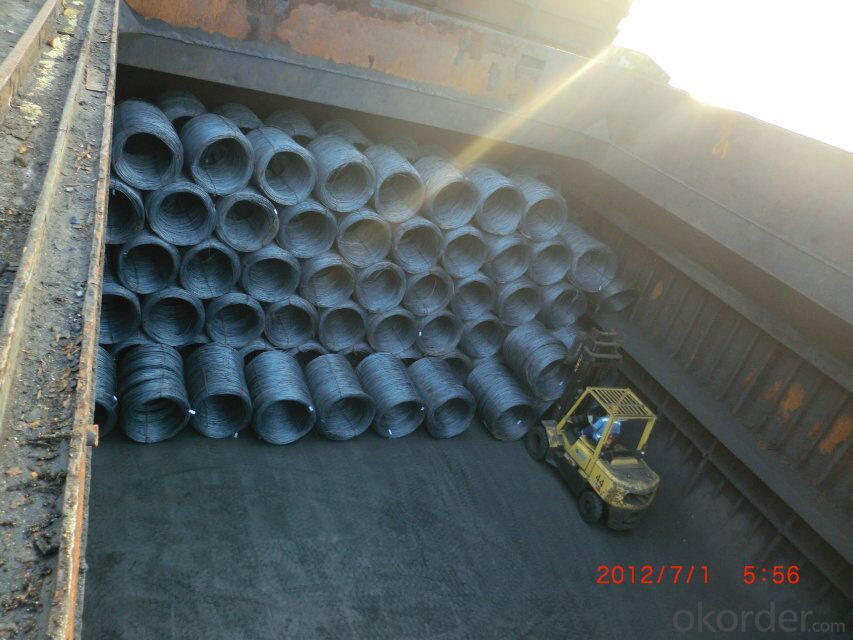
- Q: How is steel wire rod used in the manufacturing of medical devices?
- Steel wire rod is used in the manufacturing of medical devices in various ways. It can be shaped and formed into different components such as springs, coils, and meshes, which are essential for the functionality and structural integrity of medical devices. Additionally, steel wire rod is often used as a reinforcement material in surgical instruments, catheters, and orthopedic implants, providing strength and durability to these devices.
- Q: What are the different types of steel wire rod surface defect classification and grading systems?
- There are several types of steel wire rod surface defect classification and grading systems used in the industry. Some common ones include the ASTM E45 standard, which classifies defects based on their size and severity, and the ISO 4962 standard, which further categorizes defects into specific types such as cracks, scales, and pits. Additionally, some companies may have their own internal systems tailored to their specific production processes and quality requirements.
- Q: What are the different mechanical testing methods used for steel wire rod?
- The quality and performance of steel wire rod can be assessed through several commonly used mechanical testing methods. These methods include: 1. Tensile testing, which measures the ultimate tensile strength, yield strength, and elongation of the wire rod by applying a pulling force until it breaks. This test helps determine the wire rod's ability to withstand stretching or pulling forces without breaking. 2. Hardness testing, which evaluates the wire rod's resistance to indentation or penetration by a hard object. Different hardness testing methods, such as Brinell, Rockwell, and Vickers, can be used to measure the wire rod's strength and durability. 3. Bend testing assesses the wire rod's ability to withstand bending forces without failure by bending it to a specified angle and examining it for cracks or fractures. This is important for applications requiring flexibility or resistance to deformation. 4. Fatigue testing evaluates the wire rod's resistance to repeated loading and unloading cycles, which it often experiences during its service life. This test helps determine its endurance limit, fatigue strength, and fatigue life, ensuring its reliability in applications with dynamic or cyclic loads. 5. Impact testing measures the wire rod's ability to absorb energy and resist fracture under high-velocity loading. This is crucial for applications involving machinery or structural components that may encounter sudden impact or shock loads. By utilizing these various mechanical testing methods, manufacturers and users of steel wire rod can guarantee its quality, performance, and suitability for specific applications.
- Q: How is steel wire rod used in the manufacturing of wire rope assemblies for construction purposes?
- Steel wire rod is an essential component in the manufacturing of wire rope assemblies for construction purposes. Wire rope assemblies are widely used in construction for various applications such as lifting heavy loads, securing structures, and providing structural support. Steel wire rod serves as the raw material for producing the inner strands and outer strands of a wire rope assembly. These strands are made by twisting multiple individual wires together, forming a strong and durable rope. The wire rod used in this process is typically made from high-quality carbon steel, which provides the necessary strength and resilience required for construction applications. The manufacturing process begins with the steel wire rod being cleaned and coated with a lubricant to reduce friction during the twisting process. The wire rod is then drawn through a series of dies to reduce its diameter and increase its length. This drawing process helps to align the steel's grain structure, enhancing its strength and flexibility. Once the wire rod has been drawn, it is fed into a stranding machine where multiple wires are twisted together to form individual strands. These strands are then combined in a specific pattern to create the wire rope assembly, with the inner strands providing strength and the outer strands providing protection. The wire rope assembly is then subjected to various quality control measures to ensure it meets the required specifications for construction purposes. These measures may include testing for strength, flexibility, and resistance to corrosion. Once approved, the wire rope assembly is ready to be used in construction projects. In construction, wire rope assemblies made from steel wire rod are used for a wide range of applications. They are commonly used in cranes and hoists to lift heavy loads, providing a safe and reliable lifting solution. Wire rope assemblies are also utilized in the construction of suspension bridges, where they provide support and stability. Additionally, wire rope assemblies are used for securing structures, such as in the installation of safety barriers or anchoring systems. Overall, steel wire rod plays a crucial role in the manufacturing of wire rope assemblies for construction purposes. Its strength, durability, and versatility make it an ideal material for use in various construction applications, ensuring the safety and reliability of structures and equipment.
- Q: What are the main factors influencing the choice of steel wire rod order payment method?
- The selection of the payment method for steel wire rod orders can vary based on the specific circumstances and preferences of the parties involved. However, there are common factors that typically play a role, including: 1. Transaction volume and frequency: If the buyer and seller have a long-term and high-volume relationship, they may choose a more convenient and efficient payment method, such as open account or letter of credit. This eliminates repetitive paperwork and bank involvement, ensuring smoother and quicker transactions. 2. Trust and creditworthiness: If there is a lack of trust between the buyer and seller, or if the buyer's creditworthiness is questionable, the seller may prefer more secure payment methods like advance payment or documentary collection. These methods provide assurance that payment will be made before the goods are delivered. 3. Cost and convenience: The cost and convenience of different payment methods can also affect the decision. For example, if the buyer wants to avoid additional fees or charges associated with certain payment methods, they may choose cash in advance or electronic funds transfer. Conversely, if the seller wants to minimize administrative burden or payment processing costs, they may prefer open account or electronic payments. 4. Country-specific regulations and customs: Each country has its own regulations and customs regarding international trade and payment methods. For instance, certain countries may restrict certain payment methods or require specific documentation for customs clearance. Sellers and buyers must consider these factors when selecting a payment method. 5. Payment security and risk mitigation: The desired level of payment security and risk mitigation by the buyer and seller can also influence the choice of payment method. Methods like letter of credit or documentary collection offer higher security and risk mitigation compared to open account or cash in advance. 6. Market norms and industry practices: Prevailing market norms and industry practices can also impact the selection of payment methods. In some industries or regions, specific payment methods may be commonly used due to historical practices or preferences. In conclusion, the main factors influencing the choice of payment method for steel wire rod orders include transaction volume and frequency, trust and creditworthiness, cost and convenience, country-specific regulations and customs, payment security and risk mitigation, as well as market norms and industry practices. It is crucial for both the buyer and seller to carefully evaluate these factors in order to select the most suitable payment method for their specific situation.
- Q: How is steel wire rod used in the manufacturing of wire mesh trays?
- Steel wire rod is used in the manufacturing of wire mesh trays as it serves as the primary raw material for the production of the wire mesh. The steel wire rod is first drawn into a thin, continuous wire, which is then woven or welded to create the mesh structure of the trays. This process ensures that the wire mesh trays have a strong and durable construction, making them suitable for various applications such as organizing cables, supporting electrical components, or even acting as a base for concrete reinforcement.
- Q: How is steel wire rod used in the manufacturing of wire for fishing nets?
- Steel wire rod is essential in the manufacturing of wire for fishing nets as it serves as the primary material for producing the wire. The wire rod is initially processed through a series of drawing and annealing processes to achieve the desired diameter and strength. This drawn wire is then further processed, such as being twisted or braided, to form the intricate mesh structure of the fishing net. The high strength and durability of steel wire rod ensure that the resulting wire can withstand the tension and pressure exerted during fishing, making it an ideal material for manufacturing fishing nets.
- Q: Can steel wire rod be used for reinforcement purposes?
- Yes, steel wire rod can be used for reinforcement purposes. Steel wire rod is often used to reinforce concrete structures such as buildings, bridges, and highways. This is because steel has high tensile strength and can withstand heavy loads and stresses. When embedded in concrete, the steel wire rod helps to increase the overall strength and durability of the structure. It also helps to prevent cracking and improve the structural integrity. Steel wire rod is commonly used in the construction industry for reinforcement purposes due to its excellent mechanical properties and ability to enhance the performance of concrete structures.
- Q: What are the main factors affecting the market warranty of steel wire rod?
- The main factors affecting the market warranty of steel wire rod include the quality of the raw materials used in production, the manufacturing process, adherence to industry standards and specifications, the reputation and track record of the manufacturer, and the overall market demand and competition. Other factors such as environmental conditions, transportation and storage practices, and customer usage and handling can also influence the warranty coverage.
- Q: How is steel wire rod used in the manufacturing of wire for automotive fuel injection systems?
- Steel wire rod is an essential component in the manufacturing of wire for automotive fuel injection systems. This high-quality steel wire is used to create the various wires and cables required for these systems. One of the primary uses of steel wire rod in the manufacturing process is for the production of fuel injector wiring harnesses. These harnesses are responsible for connecting the fuel injectors to the vehicle's electronic control unit (ECU). The steel wire rod is drawn into thin and precise wires that are then braided or twisted together to form the necessary harnesses. The steel wire rod used in this process is chosen for its exceptional strength, durability, and electrical conductivity. It must be able to withstand the harsh conditions under the hood of a vehicle, including high temperatures, vibrations, and exposure to chemicals. Additionally, steel wire rod is also used in the manufacturing of other wires and cables within the fuel injection system. These include sensor cables, which transmit data from various sensors to the ECU, and power cables, which provide electrical power to the fuel injectors. Overall, steel wire rod plays a crucial role in the manufacturing of wire for automotive fuel injection systems. Its strength, durability, and electrical conductivity ensure the proper functioning and longevity of these systems, ultimately contributing to the performance and efficiency of the vehicle.
Send your message to us
high quality SAE1006 / SAE1008B Low Carbon Steel Wired Rod
- Loading Port:
- Tianjin
- Payment Terms:
- TT OR LC
- Min Order Qty:
- 25 m.t.
- Supply Capability:
- 5000 m.t./month
OKorder Service Pledge
OKorder Financial Service
Similar products
Hot products
Hot Searches
Related keywords
